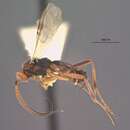Distribution
provided by Catalog of Hymenoptera in America North of Mexico
Tex., N. Mex., Ariz., Calif.; Mexico.
- bibliographic citation
- Catalog of Hymenoptera in America North of Mexico. 1979. Prepared cooperatively by specialists on the various groups of Hymenoptera under the direction of Karl V. Krombein and Paul D. Hurd, Jr., Smithsonian Institution, and David R. Smith and B. D. Burks, Systematic Entomology Laboratory, Insect Identification and Beneficial Insect Introduction Institute. Science and Education Administration, United States Department of Agriculture.
Comprehensive Description
provided by Smithsonian Contributions to Zoology
Orgilus medicaginis
This species is rather similar to detectiformis Viereck, but it differs in its normally darker abdomen, with even the venter blackish or piceous, in its basally hyaline wings, in its normally smoother second tergite, and in the head and thorax of the female being usually more or less ferruginous.
FEMALE.—Length usually 4 to 4.5 mm. Head slightly wider than thorax, about 0.65 as long as wide in dorsal view; face 1.3 as wide as eye height, shiny, punctate over most of its surface but a little rugulose just below the antennae; clypeus usually weakly punctate but occasionally strongly so; malar space longer than clypeus and half as long as eye height; cheeks shagreened and rather mat like the malar space; temples at mideye point at least 0.8 as wide as eyes, sometimes their width just about equal to eye width, rather flat and very gradually receding, smooth and shiny except narrowly along the occipital carina where they are a little shagreened; occipital carina prominent, broadly interrupted medially; frons shagreened laterally, very faintly rugulose or punctate near the ocelli; upper occiput smooth or with some weak punctures; ocellocular line about twice as long as diameter of an ocellus; antennae usually 30- to 33-segmented, some of the preapical segments at least as broad as long.
Mesoscutum smooth and shiny, with scattered shallow punctures; notauli foveolate, meeting at apex of scutum in a small rugulose area; disc of scutellum smooth; propodeum rugulose, with a small smooth area each side of the middle at base and with prominent stubs of longitudinal carinae arising from the posterior margin and setting off five apical areas that are open in front; side of pronotum closely rugulose except along upper margin; mesopleuron smooth and shiny, the longitudinal furrow strongly foveolate; metapleuron largely rugulose, weakly so in the anterior angle. Hind coxa not more than half as long as hind femur, rugulose basally above, largely smooth and shiny on outer side below; hind femur about five times as long as broad; inner calcarium of hind tibia slightly more than half as long as metatarsus; tarsal claws simple. Radial cell on wing margin just about as long as stigma; second abscissa of radius on a line with intercubitus; stub of third abscissa of cubitus at least as long as second abscissa; nervulus distinctly postfurcal, usually by about one-third its length; hind wing little more than four times as long as broad; lower abscissa of basella usually about as long as nervellus, much less than half as long as mediella and only one-third as long as maximum width of hind wing.
Abdomen a little narrower than thorax; first tergite about 1.5 times as long as broad at apex, rugulose, the dorsal keels distinct but very short, the spiracles a little farther from each other than from base; second tergite broadening slightly caudad, as long as broad at base and sometimes as long as broad at apex; second and following tergites smooth and polished, the second sometimes a little punctate or shagreened medially at base; the second suture distinct but very fine; ovipositor sheath about as long as propodeum and abdomen combined.
Head usually largely ferruginous varied with black, especially above and behind; palpi dark; antennae usually reddish brown, darkened apically; thorax varied with ferruginous and black, the pro- and mesopectus, lateral lobes of mesoscutum, metapleura, and propodeum nearly always black; tegulae and wing bases reddish yellow or reddish piceous; wings hyaline basally, weakly infumated apically; anterior and middle legs brown, their coxae testaceous, their trochanters and femora somewhat darkened above; hind legs, and especially the coxae, varying from ferruginous to black, the femora more or less darkened on the inner sides even in the palest specimens; abdomen black, the venter piceous to blackish.
MALE.—Darker than the female, the head and thorax nearly always black, except for the lower part of the clypeus and the mandibles, which are ferruginous; tegulae and wing bases sometimes reddish yellow but usually black or blackish; legs usually darker than in the female but extremely variable. The antennae of the specimens examined are 31- to 34-segmented. Usually the second tergite is relatively a little shorter than in the female.
HOLOTYPE.—USNM 70178.
DISTRIBUTION.—The type-series consists of 36 females (one the holotype) and 63 males swept from alfalfa at Elfrida, Arizona, 2 May 1956, by F. G. Werner and G. D. Butler. In addition, I have seen many specimens from other localities in Arizona, most of them swept from alfalfa but some collected on cotton; also scattered specimens collected from alfalfa or cotton in California, New Mexico, and Texas.
- bibliographic citation
- Muesebeck, Carl F. W. 1970. "The Nearctic species of Orgilus Haliday (Hymenoptera: Braconidae)." Smithsonian Contributions to Zoology. 1-104. https://doi.org/10.5479/si.00810282.30

